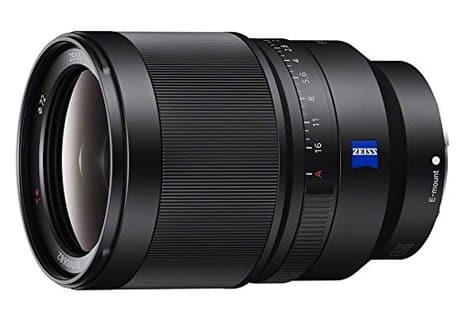Wedding photography is all about preparation. We’ve made this guide to help you find the best Sony lenses for wedding photography.
It’s a one time event, so you’ll need to have everything covered. Whether that’s zoom or prime lenses, or even both, is entirely up to your shooting style.
Many photographers usually bring more than one camera body. Then there’s the different lenses, flashes, memory cards and all of a sudden you’ve got more than you can carry.
Because weddings are a one time thing, all of the things above are more or less a requirement. Sometimes you won’t have enough time to switch between different prime lenses, so a big zoom will be far more convenient. Other times, that same zoom lens won’t have a big enough aperture for shooting at night. You can see where we’re going with this.
We checked out a ton of lenses from Sony and the list below is what we feel give you the best combination of price, image quality, sharpness, bokeh and versatility. You can still shoot weddings with a kit lens or something else of course, but the quality will be different.
This guide is for E-mount cameras, which includes all A6, A7 and A9 models.
Table of Contents
ToggleBest Sony Zoom Lenses for Weddings:
 Sony 16-35mm f/2.8 GM
Sony 16-35mm f/2.8 GM
Sony 24-70mm f/2.8 GM
Sony 70-200mm f/2.8 GM OSS
Best Sony Prime Lenses for Weddings:
Sony 24mm f/1.8 Zeiss Sony 35mm f/1.4 ZA
Sony 35mm f/1.4 ZA
Sony 35mm f/1.8G
Sony 50mm f/1.8 OSS
Sony 55mm f/1.8 OSS
Sony 85mm f/1.8
Sony 90mm f/2.8 Macro G OSS
Best Sony Zoom Wedding Lenses 2022
If you decide to buy anything after clicking on our Amazon links, you automatically support us. It’s what allows us to write guides such as this one.
1. Sony 16-35mm f/2.8

High quality zooms with f/2.8 aperture aren’t that cheap. Combined with the fact many Sony lenses tend to cost more than from other brands, it’s no wonder that the Sony 16-35mm f/2.8 GM costs over $2,000.
Is it worth it?
The 16-35mm range is for group shots, landscape, environmental portraits, indoor scenes and such. If you know you’ll be shooting in low light quite often, and that f/4 is not an option for your high ISO performance, then this is your only zoom option. There’s always prime lenses, but at the cost of no zoom. This is something you’ll have to decide on your own, but the 16-35mm is a fantastic lens nonetheless.
At weddings, you don’t always have the time to switch between different primes, and if you’re not using more than 1 body then a zoom will make your life easier.
The 16-35mm features two XA (extreme aspherical) elements and 3 aspherical elements to reduce distortion, aberration and loss of sharpness in corners. At this price range, this is expected.
While wide angle lenses aren’t something you’d use for portraits, it helps knowing there’s an 11-blade circular aperture to make bokeh look more appealing than with most other wider choices.
There’s not much else to say; auto focus is quick and accurate thanks to DDSSM (direct drive supersonic wave motor), and if you love other types of photography besides weddings, this is something you’ll never have to sell.
You can buy it at Amazon or see more reviews here.
2. Sony 24-70mm f/2.8 GM
This is a must lens! The Sony 24-70mm f/2.8 GM has the range, image quality and aperture size that make it perfect for wedding photography.
Not only that, it’s ideal for almost all other types of photography as well. Portraits, casual, food, travel, indoors, concerts etc.
This is why the price is higher than most other lenses on this list. It’s something you buy and never have to replace, and you get it because you know it will complement your shooting style. If you’re into weddings, then trust me, it will. The focal length (on APS-C and full frame) will get you covered for 90% of the shots. It allows you to be close to the action without being in the way, but also has the ability to zoom out to 24mm and capture a group shot.
Then there’s the f/2.8 aperture at all lengths. Since you’ll be shooting indoors, every extra aperture stop helps. For beautiful portraits with creamy bokeh, such a large opening is also a must!
On the inside it has 1 x Extreme Aspherical element (XA), 2 x Aspherical elements, 1 x Super ED and 1 x ED element. You’re looking at 18 elements in 13 groups so the size and weight are no surprise (31.25 oz/885g)
Yes, it’s big and heavy (31.25 oz/885g), so if these two are your main concerns then an f/2.8 zoom will probably never be a part of your kit. It’s also expensive, sitting at $1000 more than the f/4 version.
The auto focus is really fast and accurate thanks to DDSSM and it’s perfect for locking on fast moving subjects. All of that comes with a big price tag, but it’s worth it.
You can buy it at Amazon or see more reviews here.
3. Sony 70-200mm f/2.8 GM OSS

Another must for weddings. While there is a cheaper, f/4 version available, we again felt that f/2.8 is a key component here. The Sony 70-200mm f/2.8 GM OSS is a more expensive, but for certain photographers the advantages are super important.
At weddings, you’ll often be situated away from the “action” part itself in order to not attract any unwanted attention. With short zooms, you’ll be okay most of the time, but having a telephoto is a backup you can’t afford to not have. Plus, the 200mm length can make portrait shoots look absolutely stunning with such shallow depth of field.
While image quality is very similar to the f/4, the f/2.8 version features 11 vs 9 diaphragm aperture blades, slightly shorter minimum focus distance, bigger magnification (0.25x vs 0.13x). Fast and accurate auto focus and great colors even at f/2.8.
Any issues? As you’d expect, it’s heavier and bigger than the f/4 version. It could easily be too heavy if you’re using the A6 series and aren’t used to bigger lenses.
Due to f/2.8 and big zoom, this is also appropriate for other types of photography such as concerts, journalism, sports, some simple wildlife etc.
You can buy it at Amazon or see more reviews here.
Best Sony Prime Wedding Lenses 2022
1. Sony 24mm f/1.8 Zeiss
If you you don’t want to spend so much on a zoom lens, or prefer using prime lenses due to their bigger aperture and smaller design, the Sony 24mm f/1.8 is our widest pick.
Weddings, street photography, group shots, anything indoors, traveling… you name it. On an APS-C camera, it’s equivalent to a 36mm lens which is still quite wide and usable.
There’s no OSS (stabilization) like with our other prime choices below, but at 24mm the depth of field is a lot bigger which means you can shoot with long shutter speeds and still get crisp results. If your camera has stabilization built-in, then there’s nothing worry about at all.
The lens is very sharp, images have rich colors and contrast. It’s also usable at f/1.8 but corner sharpness gets better as you stop down of course. Auto focus is also quick and silent, and it rarely hunts in bad light (review at PhotographyBlog).
Best of all, it’s compact, light and easy to use for both manual and auto focus. Lenses can hunt indoors, and at such moments you’ll have to focus manually.
You can buy it at Amazon or see more reviews here.
2. Sony 35mm f/1.4 ZA

The Sony 35mm f/1.4 ZA is a brilliant piece of glass. It’s tack sharp, focuses quickly and has great image quality.
There’s 3 spherical elements inside, as well as Zeiss anti-reflective coating that improves contrast from center to the edges.
Due to its length, it’s great for both landscape, indoors, as well as portraits and group shots. The f/1.4 aperture makes it good to shoot in low light, while a 9 blade aperture will make that bokeh appear soft.
It’s quite big and expensive though, so if you’re against bigger lenses then this is not for you. Nothing abnormal of course, just, bigger than the average.
However, if you’re looking for the ultimate image quality, with very little distortion and chromatic aberration, the Sony 35mm f/1.4 ZA is the one.
You can buy it at Amazon or see more reviews here.
3. Sony 35mm f/1.8
The cheaper brother of the lens above. The Sony 35mm f/1.8G OSS provides an excellent length for portraits, weddings, casual photography and low light scenes.
For low light photography, an aperture f/1.8 is always good to have. Compared to f/2.8, it lets in almost twice as much light and you’ll appreciate it when shooting in low light and trying to use a fast shutter speed, or keep the ISO low.
For achieving a shallow depth of field (blurred background), a big aperture is also a must, anything bigger or equal to f/2.8. This makes it great for portraits, weddings, pets and whenever you want your subject to pop out.
The lens is really light (5.5 oz/155g) and accepts 49mm filters. For shooting on to go, or traveling light, the focal length + weight make it an excellent companion. Its auto focus is quick and accurate although you can expect it to hunt a little bit in low light.
You can buy it at Amazon or see more reviews here.
4. Sony 50mm f/1.8 OSS
You’ll need a 50mm prime if you want to shoot with a prime lens. For casual shots and portraits, this affordable Sony 50mm f/1.8 OSS is awesome.
The 50mm length on APS-C is equivalent to a 75mm lens on full frame. It sits between the ‘standard’ and ‘telephoto’ range so it it’s good for both casual (but not wide) photography and weddings, concerts, any situation where you can’t always be too close to your subject.
It’s more or less like the 35mm above; same aperture, similar weight and size. The 50mm is around $150 cheaper though! Quality wise, it’s similar to 50mm f/1.8’s from other brands; usable and sharp at f/1.8, but by f/4 everything gets even better (including corners). But if you’re shooting in low light and want good results, you can expect them at f/1.8 so no worries.
If you’re just starting out with weddings and don’t want to spend a fortune yet, this is what you should get. However, if you already know you want even more, read further.
You can buy it at Amazon or see more reviews here.
5. Sony 55mm f/1.8 OSS

For a few hundred dollars more, but still less than $1000, we have the famous Sony 55mm f/1.8 ZA.
If we had to pick one prime lens that would be good for a whole lot of different things (weddings, portraits, low light, casual, travel etc.), this is what we would pick.
At f/1.8 it’s already really sharp, especially in the center. Stopping down to f/2.8 or f/4 delivers impressive results, but it’s good to know that you can actually use it at f/1.8. Vignetting and chromatic aberration at f/1.8 will be visible, but it’s still fairly well considering better 50mm’s cost a lot more.
It’s quite light and small, so it’s perfect for hours of photographing (hiking, traveling, weddings). Fits very well with the A7 bodies and won’t make your back hurt. Thanks to 9 diaphragm blades, bokeh looks really good too.
Simply put, for both outdoor and indoor work, unless you shoot wildlife, you’ll love the 55mm f/1.8. The length, sharpness and size make it one of the most versatile primes for any Sony body.
You can buy it at Amazon or see more reviews here.
6. Sony 85mm f/1.8

85mm lenses are great for both FF and APS-C users. The Sony 85mm f/1.8 is quite cheap and delivers optically great images.
A 85mm lens, on any system, is a dream come true for wedding/portrait photographers. The length alone will make your subject pop out, let alone the f/1.8 aperture with 9 diaphragm blades.
It has a minimum distance of 2.63 feet (0.80cm), features an ED glass element that improves overall sharpness and shows rich colors. Its design is moisture and dust resistant, which at this price as a nice plus.
Auto focus is also very quick thanks to the Double Linear motor. Unfortunately, there’s no image stabilization which is a standard for 85mm f/1.8 lenses, regardless of the brand. If your Sony camera has OSS built-in then that’s great, if not, then that’s a disadvantage you’ll have to counter by shooting with a high ISO/bigger aperture/slower shutter speed.
You can buy it at Amazon or see more reviews here.
7. Sony 90mm f/2.8 Macro G OSS
Sharpest macro for Sony, optically superb
The Sony 90mm f/2.8 Macro GM OSS can be used for more than just bugs and other small subjects. You could use it for details, small subjects, portraits, close sports or pretty much anything that you shoot.
Like 99% macro lenses, the Sony 90mm is razor sharp and produces beautiful images with rich colors and contrast. If you occasionally shoot macro but want something for portraits, you might just fall in love with it. 85 to 135mm is usually the most preferred length for portrait photography, at least for isolating your subject or when you can’t get too close.
Not to mention the shallow depth of field you get with a short-telephoto lens paired with f/2.8. Its minimum focus distance is 0.92 ft (0.28 m) and as expected, it has a 1:1 magnification ratio. For quiet and accurate focusing, it uses DDSSM (Direct Drive motor) which helps a lot when you want to stay quiet.
The lens has OSS and combined with the A7’s series built-in stabilization, you can use it the lens with slower shutter speeds when not using a tripod. Great for those times when you want to travel light.
You can buy it at Amazon or see more reviews here.
How to Choose a Sony Lens for Weddings?
Versatility – Zoom or Prime?
Weddings are a one time event so you’ll need to be prepared for pretty much anything. A zoom lens allows you to quickly capture a moment without changing lenses, thus being able to be prepared for everything, at any time.
Many people use prime lenses and we’re not saying they’re not good or anything, it’s just that unless you’re a little bit experienced, carrying only a prime may not be the best option when starting out. You might not know how to position yourself properly yet, you might not have the full confidence to move freely etc.
In reality, the best choice would be a combination of both; 2-3 good zooms and a couple of primes that you use when you want to get a specific look. This is not the most budget friendly way of course, so we recommend starting out with an all-around f/2.8 zoom. There’s a good article about what to choose at B&H.
- Verdict: Bring zoom lenses if you want to be as secure as possible. Many people use primes only, but most do that after shooting a few weddings so they know what they need. Best case scenario, bring both types of lenses so you get awesome shots in every situation
Image Quality
Whether you’re getting paid for the wedding or doing it for free, you want to have the best image quality in both cases.
Most cheaper zooms aren’t sharp enough, which is why you don’t to buy just the first thing you see. The majority of them only show good quality when stopped down a little bit, but that means their aperture will most likely be too small for any indoor work. While your talent, skills and timing are the most important, having the right gear helps tremendously when shooting a wedding.
Prime lenses on other hand have one fixed focal length, which means the quality can be much higher. This is also true for even the cheapest primes such as the Sony 35mm f/1.8. By having fewer glass elements, there are less issues with ghosting, flare and aberration, but even here this all gets improved as you spend more.
If you’re interested in what other Sony shooters use (camera & lens), check out this article on lenses at ThePhoblographer.
- Verdict: For weddings, you’ll want the highest possible quality. It’s better to save until you can afford a good lens, or even rent one if it’s a one time event and you’re not sure about the future yet.
Big Aperture & Image Stabilization
Weddings take place outside and inside. Because of the latter, you need to be prepared with f/2.8 lenses or even bigger.
Having a big aperture allows you to really blur the background and isolate your main subject from the background. If shooting indoors, you’ll probably have to raise the ISO anyways, but some cameras will simply be too noisy. A difference between an f/2.8 and f/2 aperture is 1 f-stop, which would mean you can shoot with ISO 1600 instead of 3200.
Optical SteadyShot (OSS) is also a very welcome feature. People do move at weddings, but for the most part there’s not much movement. In those situations, OSS can help you up stabilize up to 4 stops with the majority of lenses we recommend. If your camera has it built-in then that’s even better.
Find the Perfect Sony Lens
If you’re looking to narrow down the options based on a specific type of photography or if you’re trying to figure out what the best lenses are for a particular Sony camera then check out our simplified guide to finding the best Sony lenses by using our “5 star” selection system.
Related Articles
Best Sony Lenses
Trying to find the best lens for your Sony Camera? Are you looking for the best compatible lenses for your...
Read MoreFirst and foremost, I’m a husband and father. Then professionally I’m photographer, designer, blogger, and Esty store owner. My homebase is near the stunning Wasatch mountains in Utah but I love traveling with my family as part of our homeschooling journey. I also love teaching and helping out others. My faith is one of the biggest aspects of my life and brings be a consistent joy that I haven’t found in anything else. My main blog is BestPhotographyGear.com and I strive to make photography simple for anyone looking to learn or find gear for their individual needs. By nature, I like to study, research, and analyze things and I use that help provide the best advice and reviews I can.












